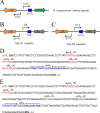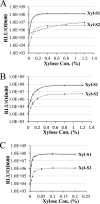Development of a tunable wide-range gene induction system useful for the study of streptococcal toxin-antitoxin systems
- PMID: 23934493
- PMCID: PMC3811191
- DOI: 10.1128/AEM.02320-13
Development of a tunable wide-range gene induction system useful for the study of streptococcal toxin-antitoxin systems
Abstract
Despite the plethora of genetic tools that have been developed for use in Streptococcus mutans, the S. mutans genetic system still lacks an effective gene induction system exhibiting low basal expression and strong inducibility. Consequently, we created two hybrid gene induction cassettes referred to as Xyl-S1 and Xyl-S2. Both Xyl-S cassettes are xylose inducible and controlled by the Bacillus megaterium xylose repressor. The Xyl-S cassettes each demonstrated >600-fold-increased reporter activity in the presence of 1.2% (wt/vol) xylose. However, the Xyl-S1 cassette yielded a much higher maximum level of gene expression, whereas the Xyl-S2 cassette exhibited much lower uninduced basal expression. The cassettes also performed similarly in Streptococcus sanguinis and Streptococcus gordonii, which suggests that they are likely to be useful in a variety of streptococci. We demonstrate how both Xyl-S cassettes are particularly useful for the study of toxin-antitoxin (TA) modules using both the previously characterized S. mutans mazEF TA module and a previously uncharacterized HicAB TA module in S. mutans. HicAB TA modules are widely distributed among bacteria and archaea, but little is known about their function. We show that HicA serves as the toxin component of the module, while HicB serves as the antitoxin. Our results suggest that, in contrast to that of typical TA modules, HicA toxicity in S. mutans is modest at best. The implications of these results for HicAB function are discussed.
Figures





References
-
- Barsamian-Wunsch P, Park JH, Watson MR, Tinanoff N, Minah GE. 2004. Microbiological screening for cariogenic bacteria in children 9 to 36 months of age. Pediatr. Dent. 26:231–239 - PubMed
-
- Bowden GH. 1990. Microbiology of root surface caries in humans. J. Dent. Res. 69:1205–1210 - PubMed
-
- Nobre dos Santos M, Melo dos Santos L, Francisco SB, Cury JA. 2002. Relationship among dental plaque composition, daily sugar exposure and caries in the primary dentition. Caries Res. 36:347–352 - PubMed
-
- Thenisch NL, Bachmann LM, Imfeld T, Leisebach Minder T, Steurer J. 2006. Are mutans streptococci detected in preschool children a reliable predictive factor for dental caries risk? A systematic review. Caries Res. 40:366–374 - PubMed
Publication types
MeSH terms
Substances
Associated data
- Actions
Grants and funding
LinkOut - more resources
Full Text Sources
Other Literature Sources

